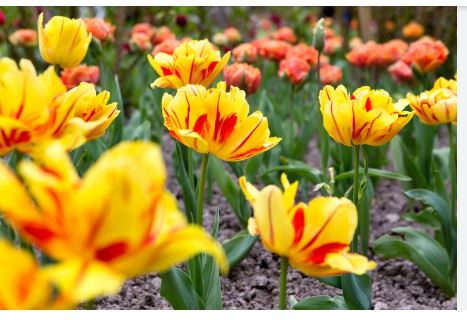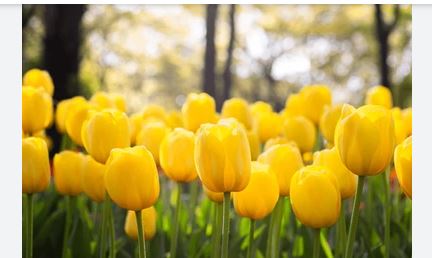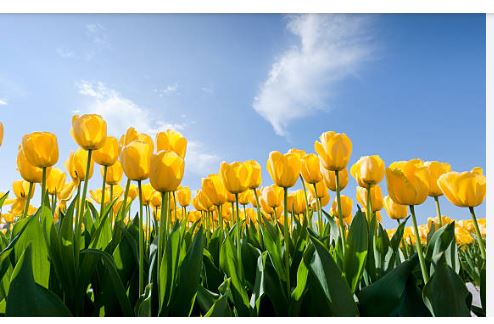
Yellow tulips, radiant beacons of spring, bring warmth and joy to gardens with their sunny hues. Symbolizing happiness and friendship, these vibrant blooms are a versatile choice for borders, containers, or cut flowers. Their cheerful color pairs beautifully with purples, whites, or reds, creating dynamic spring displays. Thriving in USDA zones 3–7, they require a cold period to bloom, making them ideal for temperate climates.
These tulips bloom from early to late spring, offering a range of shapes from classic cups to ruffled forms. They prefer full sun and well-drained soil, ensuring vivid colors and sturdy stems. While some varieties return yearly, many are treated as annuals for consistent performance. Planting in fall allows roots to establish for a dazzling spring show, perfect for uplifting any landscape.
Yellow tulips are low-maintenance, needing minimal water once established, which supports eco-friendly gardening. They attract early pollinators like bees, enhancing biodiversity, but their bulbs are toxic if ingested, so keep them away from pets. Their bright color boosts mood, making them a favorite for both gardens and bouquets, embodying spring’s renewal.
To grow yellow tulips, plant bulbs 6–8 inches deep in fall, in a sunny, well-drained spot. Apply fertilizer post-bloom and let foliage wither naturally to store energy. Protect from rodents with mulch or mesh. Whether in formal beds or naturalized lawns, yellow tulips deliver a burst of sunshine, transforming any space into a springtime haven.

Why Choose Yellow Tulips for Your Garden?
Yellow tulips are more than just a pop of color; they evoke warmth, optimism, and energy, making them a favorite for spring gardens. Their versatility allows them to pair beautifully with other spring blooms like daffodils, purple hyacinths, or red tulips, creating dynamic contrasts or harmonious sunny displays. Available in shades from pale lemon to deep gold, yellow tulips suit various garden styles, from formal beds to wildflower meadows. Most tulips thrive in USDA zones 3–7, requiring a 12–14-week cold period to bloom, though some species tulips tolerate warmer zones (7–8) with pre-chilling. Whether you’re naturalizing bulbs in a lawn or forcing them indoors, yellow tulips offer endless possibilities.

Yellow Tulip Varieties
1. Golden Apeldoorn (Darwin Hybrid)
Golden Apeldoorn, a classic Darwin Hybrid, is a mid- to late-season bloomer (April–May) renowned for its large, egg-shaped golden-yellow flowers on sturdy 20–24-inch stems. With a heat level of vibrancy that resists fading, this variety is ideal for mass plantings or cut flowers, featuring black anthers that add contrast. Its weather-resistant blooms and ability to perennialize for up to five years make it a top choice for reliable spring displays. Plant in full sun with well-drained soil, and pair with red Apeldoorn for a dynamic contrast. Golden Apeldoorn is perfect for gardeners seeking bold, long-lasting yellow tulips.
2. Yellow Spring (Single Early)
Yellow Spring, a Single Early tulip, kicks off the season in March or early April with vibrant golden-yellow, cup-shaped blooms on compact 10–14-inch stems. Its sturdy form withstands early spring winds, making it ideal for rock gardens, borders, or forcing indoors. The slightly fragrant flowers add a cheerful touch to small spaces, though they may not return reliably after the first year. Plant in full sun with well-drained, neutral soil, and combine with purple crocuses for a striking early display. Yellow Spring is a must-have for gardeners craving an early burst of sunshine.
3. Monte Carlo (Double Early)
Monte Carlo, a Double Early tulip, blooms in early to mid-April with lush, peony-like, double yellow flowers on 12–16-inch stems. Its bright, buttery blooms are fragrant and long-lasting, making them excellent for cutting or container gardening. This variety’s heavy flowers require wind protection but reward with a luxurious display when paired with blue muscari. Plant in full sun and well-drained soil, and deadhead post-bloom to conserve bulb energy. Monte Carlo is perfect for adding a touch of opulence to spring gardens or patios.
4. Golden Prince (Triumph)
Golden Prince, a Triumph tulip, blooms in mid to late spring (April–May) with rich golden-yellow, egg-shaped flowers on strong 16–20-inch stems. Its classic tulip form and cold-hardiness make it versatile for borders, beds, or cut flowers. This variety is reliable for forcing indoors and often returns for a few years if foliage is left to wither naturally. Plant in well-drained soil with full sun to intensify its color, and pair with white Shirley tulips for elegance. Golden Prince is ideal for gardeners seeking a dependable, vibrant yellow tulip.
5. Big Smile (Single Late)
Big Smile, a Single Late tulip, blooms in May with oversized, bright yellow, goblet-shaped flowers on tall 24–30-inch stems. Its elegant form and silky texture make it a favorite for formal gardens and floral arrangements. This variety thrives in full sun and neutral to slightly alkaline soil, offering a late-season burst of color. Allow foliage to die back naturally to encourage reblooming, and pair with purple alliums for a bold contrast. Big Smile is perfect for gardeners wanting tall, showy yellow tulips to cap the spring season.
6. West Point (Lily-Flowered)
West Point, a Lily-Flowered tulip, blooms in late spring (May) with graceful, mid-yellow petals that reflex into a star-like shape on 16–22-inch stems. Its wavy-edged flowers add elegance to beds or vases, but its delicate form requires wind protection. Plant in full sun and well-drained soil, and combine with blue forget-me-nots for a soft, romantic look. West Point is ideal for gardeners seeking a refined yellow tulip with a unique silhouette, perfect for adding sophistication to spring displays.
7. Yellow Emperor (Fosteriana)
Yellow Emperor, a Fosteriana tulip, blooms early to mid spring (March–April) with massive, golden-yellow, bowl-shaped flowers (5–10 inches across) on 12–18-inch stems. Its robust, weather-resistant blooms and faint red flush make it a standout for naturalizing or borders. This variety often returns for years, thriving in full sun and moist, well-drained soil. Pair with white daffodils for a classic spring combo. Yellow Emperor is perfect for gardeners wanting bold, early yellow tulips with perennial potential.
8. Spring Green (Viridiflora)
Spring Green, a Viridiflora tulip, blooms in late spring (May) with creamy yellow petals streaked with prominent green feathering on 14–18-inch stems. Its long-lasting blooms are ideal for modern arrangements or rock gardens, adding a fresh, contemporary flair. Plant in full sun and well-drained soil, and pair with purple tulips like Purple Prince for contrast. Deadhead to preserve bulb energy, as this variety may not perennialize reliably. Spring Green is a top pick for gardeners seeking unique, green-accented yellow tulips.
9. Yellow Parrot (Parrot)
Yellow Parrot, a Parrot tulip, blooms in late spring (May) with heavily ruffled, bright yellow petals on 16–24-inch stems, creating a tropical, flamboyant effect. Its oversized, feathery flowers are stunning in beds or as cut flowers but need wind protection due to their delicate structure. Plant in full sun and well-drained soil, and pair with sturdy alliums to balance its exuberance. Yellow Parrot is ideal for gardeners wanting exotic, statement-making yellow tulips, though it’s often treated as an annual.
10. Tulipa tarda (Species)
Tulipa tarda, a Species tulip, is a petite, early-blooming (March–April) variety with star-shaped, yellow petals edged in white, growing 4–6 inches tall. This botanical tulip naturalizes reliably, forming clumps in rock gardens or wildflower lawns. It thrives in full sun and well-drained, neutral to alkaline soil, returning annually with minimal care. Pair with dwarf irises for a delicate spring display. Tulipa tarda is perfect for gardeners seeking low-maintenance, perennial yellow tulips with a naturalistic charm.
11. Monsella (Double Early)
Monsella, a Double Early tulip, blooms in early April with double, golden-yellow flowers streaked with red flames on 12–16-inch stems. Its peony-like blooms are fragrant and ideal for pots, borders, or cutting, adding a hot-toned vibrancy to spring gardens. Plant in full sun and protect from strong winds to preserve its heavy flowers. Combine with blue hyacinths for a bold contrast. Monsella is a favorite for gardeners wanting lush, colorful yellow tulips with a fiery twist.
12. Daydream (Darwin Hybrid)
Daydream, a Darwin Hybrid, blooms in mid to late spring (April–May) with creamy yellow flowers that mature to a warm apricot-yellow on 20–24-inch stems. Its color-shifting blooms and weather resilience make it a dynamic choice for beds or cut flowers. This variety perennializes well, returning for years in well-drained, sunny sites. Pair with red Banja Luka for a tropical vibe. Daydream is ideal for gardeners seeking versatile, long-lasting yellow tulips with evolving hues.
13. Arma (Fringed)
Arma, a Fringed tulip, blooms in mid to late spring (April–May) with yellow petals tipped with red crystalline fringes on 16–20-inch stems. Its serrated edges add texture to beds or bouquets, making it a standout in mixed plantings. Plant in full sun and well-drained soil, and pair with white daffodils to highlight its fringed beauty. Arma is perfect for gardeners wanting a unique, textured yellow tulip to elevate spring displays.
14. Candela (Fosteriana)
Candela, a Fosteriana tulip, blooms early to mid spring (March–April) with pure yellow, bowl-shaped flowers on 10–16-inch stems. Its soft fragrance and robust form make it ideal for borders or naturalizing, often returning for years. Plant in full sun and moist, well-drained soil, and combine with grape hyacinths for a vibrant spring scene. Candela is a top choice for gardeners seeking early, reliable yellow tulips with a classic appeal.
15. Yellow Madonna (Single Late)
Yellow Madonna, a Single Late tulip, graces gardens in May with its elegant, goblet-shaped, pure yellow flowers on tall 24–30-inch stems. Its silky, vibrant petals make it a standout for formal gardens or as a cut flower in sophisticated bouquets. Blooming late in the spring season, this variety thrives in full sun and well-drained, neutral to slightly alkaline soil. To encourage reblooming, allow foliage to wither naturally after flowering. Pair Yellow Madonna with purple Queen of Night tulips for a regal contrast or plant en masse for a golden finale to your spring display. Its tall stature and classic form make it ideal for gardeners seeking a refined, late-season yellow tulip.
16. Moonlight Girl (Lily-Flowered)
Moonlight Girl, a Lily-Flowered tulip, blooms in late spring (May) with delicate, lemon-yellow petals that fade to creamy yellow, forming a star-like shape on 16–22-inch stems. Its pointed, reflexed petals add a graceful, almost ethereal quality to beds or vases, but its slender form requires wind protection. Plant in full sun with well-drained soil, and combine with blue forget-me-nots or pink Marilyn tulips for a soft, romantic look. Moonlight Girl is perfect for gardeners wanting a subtle yet elegant yellow tulip that brings a touch of whimsy to spring gardens, especially in mixed borders.
17. Golden Davenport (Fringed)
Golden Davenport, a Fringed tulip, blooms in mid to late spring (April–May) with golden-yellow petals adorned with subtle red crystalline fringes on 16–20-inch stems. The serrated edges lend a textured, almost sparkling effect, making it a focal point in beds or floral arrangements. This variety thrives in full sun and well-drained soil, pairing beautifully with white daffodils or solid-colored tulips like Purple Prince to highlight its unique fringing. Golden Davenport is ideal for gardeners seeking a vibrant yellow tulip with a distinctive, ornate appearance, adding flair to both modern and traditional garden designs.
18. Yellow Spring Green (Viridiflora)
Yellow Spring Green, a Viridiflora tulip, blooms in late spring (May) with bright yellow petals subtly streaked with green feathering on 14–18-inch stems. Its fresh, contemporary look and long-lasting blooms make it a favorite for modern arrangements, rock gardens, or containers. Plant in full sun and well-drained soil, and pair with purple Negrita tulips for a bold contrast or white pansies for a softer palette. Deadhead to conserve bulb energy, as this variety may not perennialize reliably. Yellow Spring Green is perfect for gardeners wanting a vibrant yellow tulip with a green-accented twist.
19. Apricot Parrot (Parrot)
Apricot Parrot, a Parrot tulip, blooms in late spring (May) with oversized, ruffled yellow-apricot petals streaked with green and pink on 16–24-inch stems. Its flamboyant, tropical appearance makes it a showstopper in beds or as a cut flower, though its heavy blooms need wind protection. Plant in full sun and well-drained soil, and pair with sturdy alliums or blue salvia to balance its exuberance. Apricot Parrot is often treated as an annual but offers unmatched drama for gardeners seeking exotic yellow tulips with a vibrant, multi-hued flair.
20. Banja Luka (Darwin Hybrid)
Banja Luka, a Darwin Hybrid, blooms in mid to late spring (April–May) with large, egg-shaped yellow flowers streaked with red flames on robust 20–24-inch stems. Its tropical vibe and weather-resistant blooms make it ideal for mass plantings or cut flowers, with a strong perennializing tendency. Plant in full sun and well-drained soil, and combine with Golden Apeldoorn for a fiery, hot-toned display. Banja Luka is a top choice for gardeners wanting bold, long-lasting yellow tulips that add a dynamic, bicolor punch to spring gardens.
21. Flair (Single Early)
Flair, a Single Early tulip, blooms in March or early April with bright yellow petals edged in red on compact 10–14-inch stems. Its bicolor, cup-shaped flowers are slightly fragrant and withstand early spring winds, making it perfect for rock gardens, borders, or indoor forcing. Plant in full sun and well-drained, neutral soil, and pair with purple crocuses or blue muscari for a vibrant early display. Flair is ideal for gardeners seeking a cheerful, bicolor yellow tulip to kick off the spring season with flair.
22. Early Harvest (Triumph)
Early Harvest, a Triumph tulip, blooms in mid-spring (April) with buttery yellow petals faintly flushed with orange on sturdy 16–20-inch stems. Its cold-hardy, egg-shaped blooms are versatile for borders, beds, or cut flowers, and it’s reliable for indoor forcing. Plant in well-drained soil with full sun to enhance its warm tones, and pair with white Shirley tulips or grape hyacinths for a harmonious look. Early Harvest is perfect for gardeners wanting a reliable, mid-season yellow tulip with a soft, glowing presence.
23. Verona (Double Early)
Verona, a Double Early tulip, blooms in early to mid-April with pale yellow, peony-like flowers flushed with green on 12–16-inch stems. Its fully double, fragrant blooms are ideal for containers, front borders, or cutting, adding a fresh, spring-like elegance. Protect its heavy flowers from strong winds, and plant in full sun with well-drained soil. Pair with blue hyacinths or pink Foxtrot tulips for a pastel spring palette. Verona is a favorite for gardeners seeking lush, soft yellow tulips with a romantic charm.
24. Yellow Crown (Triumph)
Yellow Crown, a Triumph tulip, blooms in mid to late spring (April–May) with slightly ruffled, golden-yellow petals on 16–20-inch stems. Its textured, egg-shaped flowers add depth to mixed beds and make excellent cut flowers, often returning for a few years if foliage is left to wither. Planta in full sun and well-drained soil, and combine with purple Paul Scherer tulips for a striking contrast. Yellow Crown is ideal for gardeners wanting a vibrant, slightly textured yellow tulip for versatile spring displays.
25. Gold Fever (Single Late)
Gold Fever, a Single Late tulip, blooms in May with deep yellow, goblet-shaped flowers with slightly pointed petals on 24–30-inch stems. Its rich, golden hue and tall stature make it a standout for formal gardens or bouquets, offering a luxurious late-season finale. Plant in full sun and neutral to slightly alkaline soil, and pair with purple alliums or white Maureen tulips for elegance. Gold Fever is perfect for gardeners seeking a bold, statuesque yellow tulip to extend the spring season.
26. Yellow Spider (Lily-Flowered)
Yellow Spider, a Lily-Flowered tulip, blooms in late spring (May) with spidery, golden-yellow petals that reflex into a dramatic, star-like shape on 16–22-inch stems. Its exotic form adds flair to beds or vases but needs wind protection due to its delicate structure. Plant in full sun and well-drained soil, and pair with blue camassias or pink Ballade tulips for a vibrant, modern look. Yellow Spider is a top pick for gardeners wanting a unique, eye-catching yellow tulip with an architectural edge.
27. Fancy Frills (Fringed)
Fancy Frills, a Fringed tulip, blooms in mid to late spring (April–May) with ivory-white petals transitioning to yellow and pink fringed tips on 16–20-inch stems. Its crystalline, serrated edges create a soft, romantic effect, perfect for mixed plantings or bouquets. Plant in full sun and well-drained soil, and pair with solid yellow Golden Davenport to highlight its delicate fringing. Fancy Frills is ideal for gardeners seeking a multi-hued, textured yellow tulip for a whimsical spring touch.